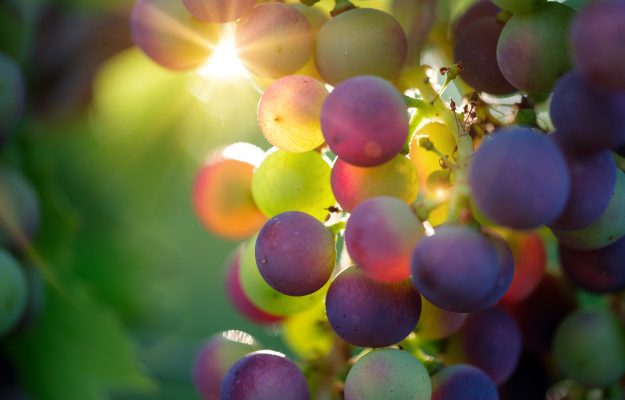Italy is boiling hot. Its lakes and rivers are below warning levels, and agriculture fears from -30% to -70% losses in grains, rice, fruit and vegetable crops. Barring sensational surprises, in a few days’ time, the Italian Government will declare a state of emergency as the Regions, especially those in the North that are having the most difficulty, have requested. The hypotheses on the table are rationing water, especially for human and agricultural consumption. One might think about not filling up swimming pools, for example, or limiting hydroelectric energy production. It is a very challenging issue to deal with, however, considering skyrocketing energy costs and Russia cutting gas supplies. In any case, on the first day of summer so many territories haven’t had rainfall for 3-4 months, this emergency situation is definitely due to climate change, which, however, is not today's phenomenon, but we will have to reckon with it in the future. And viticulture will have to as well. Further, many say that the situation on June 21st, first day of summer, in the vineyards, except for sporadic cases, is not yet dramatic, tomorrow however is truly worrying. And in this context, the first focus of the Veneto Wine Triptych 2022 of the Veneto Region, Veneto Agriculture, ARPAV and UVIVE revealed that the first alarms were launched by the Consortium of Barbera d'Asti and Vini del Monferrato, led by Filippo Mobrici, "covering" a third of the Piedmont vineyard, as well as Veneto, another Region driving Italian wine. Furthermore, if it does not rain in the next few days, the situation, in view of the harvest, could become truly dramatic. Plus, the more distant future will be impacted, which, most likely, will have to impose fundamental changes in the Italian vineyard, organizationally (reservoirs, ponds, infrastructures), as well as agronomically. More suitable techniques for what will be a more and more arid-hot viticulture will be needed. Vineyards will need to be managed also by genetic research on rootstocks as well as new varieties that can managing water scarcity, which seems destined to become a constant. And, we must start by clarifying a "narrative" misunderstanding. That is, it is not true that the vine, under water stress, produces higher quality. This is the synthesis from testimonies of oenologists, agronomists and academics that WineNews has gathered, from authoritative voices such as Attilio Scienza and Leonardo Valenti, professors at the University of Milan, Riccardo Cotarella, president of Assoenologi, and Andrea Lonardi , agronomist and Chief Operations Officer of Angelini Wines & Estates (in line to soon become the next Italian Master of Wine).
“We are experiencing very difficult times”, Andrea Lonardi told WineNews, “and, it is not true that vines resist drought well. Or rather, it is true that drought can influence quality, especially in some varieties; the first that comes to mind is Sangiovese. We are seeing things we had never seen before. Up to the 2000s, climate change had positive effects, and some territories changed quality - wise. Today, however, the situation has completely changed, and I see some Regions struggling quite a bit, a situation that causes deep concern”. Obviously, things change from area to area. “Italy is divided into three areas. The Mediterranean, linked to the sea”, explained Lonardi, “which actually suffers less from this phenomenon, because it is already used to hot-arid viticulture. The area in the North also suffers less because there is usually an abundance of water, and then there is the central area made up of Tuscany, Umbria and Marche, which in my opinion, is facing a dramatic situation. We need to intervene at the company level, using short-term practices, but the fundamental thing is that Italy, as a country, must set up a work table, like other Countries have done, to make medium-long term choices. To understand, also through genetics, what to do in the next 20 years if, as the data tell us, this change will lead to an even warmer and more arid climate. There are some territories, such as Montalcino or others in Tuscany, where we are with Angelini Wines & Estates (such as Chianti Classico and Montepulciano, ed.), where I believe something needs to be done at the community level. Building basins and ponds, because water is a fundamental element, for instance, to face this risk at least in the short term. Our mindset cannot be that the more vines suffer the higher the quality — it is the opposite. But certainly, in the long run, genetic research is what will give us the most”.
“The drought in the vineyard the drought is not yet extremely worrying”, Riccardo Cotarella, president of Assoenologi, added, “except for some areas whose soils are, rich in limestone, but these are sporadic cases. As of today there is not great concern; it is almost normal vegetation. From now on, however, a greater need for water is starting, because we are moving towards berries growing, and if we still don’t have water, it will be a problem. We are hoping it rains, because the vineyard doesn't need a lot of water, about 40-50 millimeters is enough a couple of times at the right times, to guarantee the plant's water reserves. It must be said, though, that the grape production this year seems very generous and it will need more water than in the past”". And, about the future, Cotarella commented, “water falls from the sky, we cannot produce it, and therefore we need infrastructures, pipes that do not waste water, especially for domestic use. For agricultural use, instead, we need reservoirs that can contain rainwater and melted snow, to be used intelligently, as a drip, when needed” . “Looking at today's situation, it is not yet dramatic”, Professor Leonardo Valenti (University of Milan) added, “but if it continues like this for another month or two, I don't know what will happen. We must think broadly about water, that is, I believe it must be used to safeguard the life of the plant, but not to manage production. We must always keep in mind that water is a primary good, and should be used more than rationally, and only when strictly necessary. Instead, we must go towards researching rootstocks and agronomic techniques where irrigation is the only thing that comes to the rescue. When we talk about suitability, it includes these techniques. Of course, this thought process is valid only when it is a matter of producing fewer grapes and wine every now and then. If it becomes a structural situation, then there are many more things that need to be rethought, in order to reset our viticulture more extensively”. This is, in a nutshell, the same path Professor Attilio Scienza has indicated. “The narrative of the vine species that tolerates drought, unfortunately, has been strongly repudiated in the last few years”, Professor Attilio Scienza explained to WineNews, “as water availability has failed. The vine is a species that adapts to conditions of scarce water, it survives, but does not produce or produces very little. If we want a productive plant that produces grapes in the quantity and quality we desire, it must have the right water supply, and therefore, if things are not so favorable, like recently, we need remedies”. However, it is not a simple task to find them. “From an agronomic point of view”, Scienza underlined, “irrigation is considered the solution to the problem. But we must keep in mind that water is no longer available as it was in the past, and that above all, hill viticulture, which is where you need more water, is the most difficult to irrigate. This is because it is difficult to being water to the hills, requiring a lot of energy, and because the economic convenience is very low, and you have to think about alternatives. The first alternative is related to rootstocks and here, we have lost too much time. We have relied on those of the first years post phylloxera, where the problem was precisely the lack of water. We actually concluded the research on the subject at the end of the twentieth century, thinking that it was enough that the rootstocks were resistant to phylloxera and limestone, without thinking about water management in a serious way. And, there is a basic flaw. Very few genetic sources have been used, very few parents, which has not favored creating truly resistant varieties. In the nineties of the twentieth century, the University of Milan started this project about the new "M rootstocks", and two of these have proven to be interesting in terms of drought management, but we are just at the beginning of the road.
We must use the enormous genetic reserve that is present in the driest American states. In other words, the deserts of Arizona, New Mexico, Texas, where there are populations of wild plants capable of withstanding very high temperatures and very low water availability. We must start a major research project on the subject of rootstocks from there. But, this is still not enough, because it takes a long time and we need to react now. In this context”, Attilio Scienza pointed out, “in the last few years, viticulture has shifted from the hilly areas to the plains, often in territories that were not cultivated with vines, making impressive soil reclamation work to create easily accessible mechanized vineyards. In order to do this, large quantities of land have been moved, which has led to a substantial change in the characteristics of the soil tectonics. It is often underestimated, but it is crucial. Our soils are the result of phenomena that are hundreds of thousands of years old, stratification is a long process, which starts from the mother rock to reach agricultural land, creating very different layers. The plant develops various types of roots, superficial and deep, which have various roles, which allow it to manage both water and mineral functions well. Now, it is easy to imagine that the tectonics is upset when we use machines to move large quantities of earth together, and therefore, we have a polyform profile, without layers, and the root of the vine struggles to adapt because it no longer recognizes the different layers, the different horizons, how to differentiate the roots with various functions. This is readily seen in the younger plants. They are all stressed, and production decreases year by year. We have to reconstruct a culture of the soil, with deep tillage, and change the agronomic technique, thinking of an arid-viticulture. The distances between rows must increase, the rootstocks must absolutely be only those suitable for stress conditions, and rows must be wider to avoid concentrating infrared energy. These interventions are obviously not easy to accomplish, and they concern only the new plants”. And, according to Scienza, the theme of variety of lives must also be addressed. “Vines used in various eras, warmer or colder, have always been children of adaptation, chosen by man, who eliminated the ones not suitable for that phase. Well, today we are not able to do this, we are too rigid, too tied to regulations, to this concept of native grape variety linked to the territory. We now describe wine in this way, and therefore, changing grape varieties is a difficult operation. But, it is necessary. The future of climate change and rising temperatures, requires new varieties to be made, both for white and red wines. This would eliminate a whole series of drawbacks, starting from the too high alcohol content to the negative effects of solar energy on ripening, to the negative consequences on the vitality and productivity of the plants. Simply put, we need to rethink two things. The first is the suitability of soils and environments. Some are suitable, others are not, and you cannot force nature just because there is an urgent demand for a certain product. We must return to a more rigid concept of suitability, which means not only producing in quantity and quality, but also at low cost. Plus, let's keep against what is needed for irrigation is one of the most expensive energies. And then there is genetics. We need a genetic improvement project on rootstocks that can better manage drought, as well as on varieties capable of adapting to the constantly changing climate”.
Copyright © 2000/2025
Contatti: info@winenews.it
Seguici anche su Twitter: @WineNewsIt
Seguici anche su Facebook: @winenewsit
Questo articolo è tratto dall'archivio di WineNews - Tutti i diritti riservati - Copyright © 2000/2025


























































































































































































